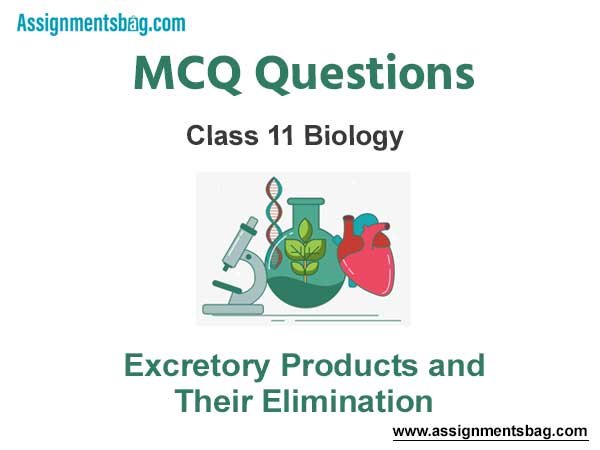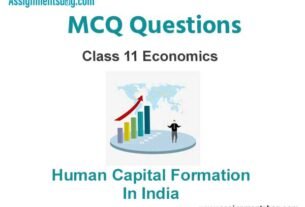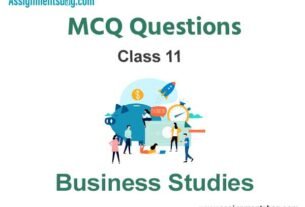Please refer to MCQ Questions Chapter 19 Excretory Products and Their Elimination Class 11 Biology with answers provided below. These multiple-choice questions have been developed based on the latest NCERT book for class 11 Biology issued for the current academic year. We have provided MCQ Questions for Class 11 Biology for all chapters on our website. Students should learn the objective based questions for Chapter 19 Excretory Products and Their Elimination in Class 11 Biology provided below to get more marks in exams.
Chapter 19 Excretory Products and Their Elimination MCQ Questions
Please refer to the following Chapter 19 Excretory Products and Their Elimination MCQ Questions Class 11 Biology with solutions for all important topics in the chapter.
MCQ Questions Answers for Chapter 19 Excretory Products and Their Elimination Class 11 Biology
Question- Which of the following is likely to accumulate in dangerous proportion in the blood of a person whose kidney is not working properly?
(a) Ammonia
(b) Urea
(c) Lysine
(d) Sodium chloride
Answer
B
Question- Which of the following is correctly matched with its function of a specific part of a human nephron?
(a) Afferent arteriole – Carries the blood away from the glomerulus towards renal vein.
(b) Podocytes – Create minute spaces (slit pores) for the filtration of blood into the Bowman’s capsule.
(c) Henle’s loop – Reabsorption of the major substances from the glomerular filtrate.
(d) Distal convoluted tubule – Reabsorption of K+ ions into the surrounding blood capillaries
Answer
B
Question-Podocytes occur in
(a) large intestine
(b) glomerulus of kidney
(c) wall of capillaries
(d) neck region
Answer
B
Question- Workers in deep mines usually suffer from dehydration because
(a) water is lost due to evaporation.
(b) water is lost due to defecation.
(c) water is lost in the form of urine.
(d) water is lost along with salts in the form of sweat.
Answer
D
Question- Atrial natriuretic factor (ANF) is released in response to the increase in blood volume and blood pressure. Which of the followings is not the function of ANF? It
(a) stimulates aldosterone secretion.
(b) inhibits the release of renin from JGA.
(c) stimulates salt loss in urine.
(d) inhibits sodium reabsorption from collecting duct.
Answer
A
Question- Which of the following sets of animals produce the same substances as their chief excretory product?
(a) Fish, pigeon and frog
(b) Camel, housefly and snake
(c) Frog, monkey and dog
(d) Amoeba, ant and antelope
Answer
C
Question- The cells named podocytes occur in
(a) inner wall of Bowman’s capsule
(b) outer wall of Bowman’s capsule
(c) in the wall of glomerulus
(d) in the wall of Henle’s loop
Answer
A
Question- Ultrafiltration occurs in a glomerulus when
(a) hydrostatic pressure exceeds osmotic pressure.
(b) osmotic pressure exceeds hydrostatic pressure.
(c) capsular hydrostatic pressure exceeds glomerular hydrostatic pressure.
(d) colloidal osmotic pressure plus capsular pressure remain less than glomerular hydrostatic pressure.
Answer
D
Question- Which blood vessel in mammals would normally carry the largest amount of urea?
(a) Dorsal aorta
(b) Hepatic vein
(c) Hepatic portal vein
(d) Renal vein
Answer
B
Question- In a mammalian kidneys, Bowman’s capsules occur in
(i) while loops of Henle are situated in (ii) .
(a) (i) – cortex, (ii) – medulla
(b) (i) – medulla, (ii) – cortex
(c) (i) – cortex, (ii) – pelvis
(d) (i) – pelvis, (ii) – medulla
Answer
A
Question- Diuresis is a condition characterized by
(a) increase in urine volume.
(b) increased glucose excretion.
(c) decrease in urine volume.
(d) decrease in electrolyte balance.
Answer
A
Question- Under normal conditions which one is completely reabsorbed in the renal tubule?
(a) Salts
(b) Urea
(c) Glucose
(d) Uric acid
Answer
C
Question- Glomerular filtrate contains
(a) blood without blood cells and proteins
(b) plasma without sugar
(c) blood with proteins but without cells
(d) blood without urea
Answer
A
Question- What will happen if the stretch receptors of the urinary bladder wall are totally removed?
(a) There will be no micturition
(b) Urine will not collect in the bladder
(c) Micturition will continue
(d) Urine will continue to collect normally in the bladder
Answer
D
Question- If the afferent arteriole that supplies blood to the glomerulus becomes dilated,
(a) the protein concentration of the filtrate decreases.
(b) hydrostatic pressure in the glomerulus decreases.
(c) the glomerular filtration rate increases.
(d) all of the above
Answer
C
Question- The urine under normal conditions does not contain glucose because
(a) the normal blood sugar is fructose.
(b) glucose of blood is not filtered in the glomerulus.
(c) glucose in glomerular filtrate is reabsorbed in the uriniferous tubules.
(d) glucose in glomerular filtrate is converted into glycogen.
Answer
C
Question- When a person is suffering from poor renal reabsorption, which one of the following will not help in maintenance of blood volume?
(a) increased ADH secretion.
(b) decreased glomerular filtration.
(c) increased arterial pressure in kidneys.
(d) decreased arterial pressure in kidneys.
Answer
C
Question- Toxic substances are detoxified in human body in
(a) kidney
(b) lungs
(c) liver
(d) stomach
Answer
C
Question-Through the thick segment of ascending limb of Henle’s loop the
(a) NaCl can pass by active transport from filtrate to the interstitial fluid.
(b) NaCl can pass by passive transport into interstitial fluid.
(c) NaCl cannot pass from the filtrate to interstitial fluid.
(d) Water can pass freely from filtrate to interstitial fluid.
Answer
A
Question- If excess water passes out from tissues without being restored by kidneys, the cells would
(a) burst open and die
(b) not be affected at all
(c) extract water from plasma
(d) shrivel and die
Answer
B
Question- A patient was diagnosed that one process of his excretory system was not functioning properly due to which his urine is not concentrating.
Identify the organ of the excretory system on which concentration of urine depends.
(a) Collecting duct
(b) Bowman’s capsule
(c) Length of loop of Henle
(d) Proximal convoluted tubules
Answer
C
Question- If the diameter of afferent renal arteriole is decreased and that of efferent renal arteriole increased, ultra filtration will
(a) be faster
(b) be slower
(c) not take place
(d) take place in the same speed
Answer
C
Question- __i___ and ___ii___ carries the waste products.
(a) i- Renal artery, ii- Renal vein
(b) i- Renal vein, ii- Urethra
(c) i- Renal vein, ii- Ureter
(d) i- Renal artery, ii-Ureter
Answer
D
Question- In a kidney machine, which of the following passes from the blood to the dialysis fluid?
(a) Glucose
(b) Plasma protein
(c) Red blood cells
(d) Urea
Answer
D
Question- In which of the following minimum content of urea is present ?
(a) Hepatic portal vein
(b) Portal vein
(c) Renal vein
(d) Vena cava
Answer
C
Question-Excretion means
(a) removal of substances which have never been a part of body.
(b) removal of faecal matter from the body.
(c) removal of substances not required in the body.
(d) all of the above.
Answer
C
Question- Filtration fraction is the ratio of
(a) glomerular filtration rate (GFR) to renal plasma flow (RPF)
(b) glomerular filtrate to urine
(c) haemoglobin to oxyhaemoglobin
(d) O2 to CO2
Answer
A
Question- Urine of a human suffering from diabetes inspidus is
(a) concentrated with glucose
(b) concentrated without glucose
(c) watery with glucose
(d) watery without glucose
Answer
D
Question- Which one of the following enables the mammalian kidney to regulate water reabsorption during states of dehydration?
(a) The cells of the tubules detect the osmotic pressure of the blood.
(b) Water is extracted from the glomerular filtrate in the proximal tubules.
(c) The kidney produces a hypotonic urine.
(d) Hormones increase the permeability of the collecting ducts.
Answer
D
Question- Which one of the following statements in regard to the excretion by the human kidneys is correct?
(a) Ascending limb of Loop of Henle is impermeable to electrolytes
(b) Descending limb of Loop of Henle is impermeable to water
(c) Distal convoluted tubule is incapable of reabsorbing HCO3–
(d) Nearly 99 per cent of the glomerular filtrate is reabsorbed by the renal tubules
Answer
D
Question- “X” causes reabsorption of “Y” and water from the distal parts of the tubule. This also leads to an increase in “Z” and glomerular filtration rate (GFR). Identify X, Y and Z.
(a) X: ADH; Y: Na+; Z: Blood pressure
(b) X: ADH; Y: K+; Z: Blood pressure
(c) X: Aldosterone; Y: Na+; Z: Blood pressure
(d) X: Aldosterone; Y: K+; Z: Ionic concentration
Answer
C
Question- In human beings the capsular urine entering the Proximal Convoluted Tubule (PCT) is
(a) isotonic to blood
(b) hypotonic to blood
(c) hypertonic to blood
(d) isotonic to sea water
Answer
A
Question- Identify the parts mentioned below which constitute a part of single uriniferous tubule.
i. Loop of Henle.
ii. Collecting duct
iii. Bowman’s capsule
iv. Distal convoluted tubule
(a) i, ii and iii
(b) ii, iii and iv
(c) i, iii and iv
(d) All of the above
Answer
C
Question- Filtration slits are formed by
(a) endothelial lining of glomerular capillaries.
(b) inner epithelium of Bowman’s capsule.
(c) basement membrane.
(d) the participation of all of these.
Answer
B
Question- Which are the following group of hormones participate in the regulation of the renal function?
(a) ADH, TSH and ANF
(b) PCT, TSH and ANF
(c) ADH, DCT and Aldosterone
(d) ADH, ANF and Aldosterone
Answer
D
Question- The end product of ornithine cycle is
(a) urea
(b) uric acid
(b) NH3
(d) CO2
Answer
A
Question- Reabsorption in tubules of nephrons occurs by
(a) osmosis
(b) diffusion
(c) active transport
(d) both (b) & (c)
Answer
D
Question- There is no sugar in urine. The blood entering the kidney has more sugar than leaving the kidney because
(a) sugar is used by kidney cells in metabolism.
(b) sugar is absorbed by bladder.
(c) sugar is absorbed by proximal convoluted tubule.
(d) sugar is absorbed in Loop of Henle.
Answer
A
Question- In nephron water absorption is maximum in
(a) proximal convoluted tubule (PCT).
(b) ascending limb of Henle.
(c) descending limb of Henle.
(d) distal convoluted tubule (DCT).
Answer
A
Question- Human urine contains
(a) 95% water, 2.6% urea, 2% salts and some uric acid.
(b) 99% water and 1% urea.
(c) 92% water and 8% salts.
(d) 90% water, 8% uric acid and 2% proteins.
Answer
A
Question- Duct of Bellini is concerned with
(a) Filtration of urine
(b) Purification of urine
(c) Conduction of urine
(d) All the above
Answer
C
Question- Which one of the following correctly explains the function of a specific part of a human nephron ?
(a) Podocytes : Create minute spaces (slit pores) for the filtration of blood into the Bowman’s capsule.
(b) Henle’s loop : Most reabsorption of the major substances from the glomerular filtrate.
(c) Distal convoluted tubule : Reabsorption of K+ ions into the surrounding blood capillaries.
(d) Afferent arteriole : Carries the blood away from the glomerular towards renal vein.
Answer
A
Question- Urine is hypertonic
(a) in Bowman’s capsule.
(b) in PCT.
(c) in the middle of descending & ascending limb of Henle’s loop.
(d) at the end of ascending limb of Henle’s loop.
Answer
B
Question- If Henle’s loop were absent from mammalian nephron which of the following is to be expected
(a) there will be no urine formation
(b) there will be hardly any change in the quality and quantity of urine formed
(c) the urine will be more concentrated
(d) the urine will be more dilute.
Answer
D
Question- Which of the following hormone/enzyme is/are correctly paired with its function?
I. Renin – Enzyme that catalyses the formation of angiotensin I.
II. Aldosterone – Regulates water reabsorption at the distal convoluted tubule.
III. Anti-diuretic hormone (ADH) – It is a powerful vasoconstrictor that stimulates the secretion of aldosterone.
IV. Angiotensin II – Promotes reabsorption of sodium at distal convoluted tubule.
(a) Only I
(b) Only III
(c) I, II and III
(d) II, III and IV
Answer
A
Question- Select the correct match of the types of organs given in column I with their role in excretion given in column II.
Column I Column II
(Types of organ) (Role in excretion)
A. Lungs I. Secretes bile-containing substances like bilirubin, biliverdin, cholesterol,
degraded steroid hormones,vitamins and drugs.
B. Liver II. Eliminates water and salts in sweat and substances
like sterols, hydrocarbons and waxes through sebum.
C. Skin III. Remove large amounts of CO2 (18 litres/day) and also significant quantities
of water every day
D. Kidney IV. Remove wastes (metabolic by-products) and regulate pH, ion concentration,
volume and osmolarity of blood
(a) A – I; B – II; C – III; D – IV
(b) A – II; B – I; C – II; D – IV
(c) A – III; B – I; C – IV; D – II
(d) A – IV; B – IV; C – III; D – I
Answer
B
Question- Which of the following parts of the nephron given in column I is correctly matched with their functions given in column II?
Column-I Column-II
(Parts of the nephron) (Functions)
A. Proximal convoluted tubules . I. Sodium is reabsorbed actively in this region
B. Distal convoluted tubules II. Sodium and water are reabsorbed under the influence of hormone
in this region.
C. Descending limb III. Primary site of glucose and amino acid reabsorption.
D. Ascending limb IV. Major substance reabsorbed here is water by osmosis
(a) A – I; B – II; C – III; D – IV
(b) A – IV; B – I; C – II; D – III
(c) A – III; B – IV; C – II; D – I
(d) A – III; B – II; C – IV; D – I
Answer
D
Question- In ornithine cycle, enzyme arginase breaks down arginine into
(a) Citrulline and ammonia
(b) Ornithine and ammonia
(c) Ornithine and urea
(d) Citrulline and urea.
Answer
C

We hope you liked the above provided MCQ Questions Chapter 19 Excretory Products and Their Elimination Class 11 Biology with solutions. If you have any questions please ask us in the comments box below.

